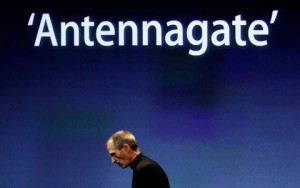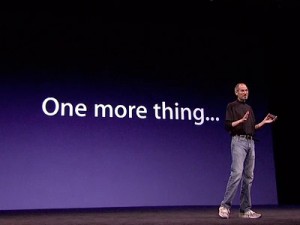Steve Jobs has generated a fair amount of reaction over how he conducted his news conference on the technical glitches suffered by Apple’s new iPhone 4.
In a recent post (Steve Jobs & His iPhone 4’s Worm), I took Jobs to task for failing to open up his briefing to live broadcast coverage and for defaulting the agenda to networks like CNBC.
Since that post, I’ve received some interesting, and compelling, reaction. One on BusinessInsider.com’s War Room page (4 Presentation Lessons From Steve Jobs’ iPhone 4 Press Conference) looks at Jobs’ presentation through the prism of social media, definitely a valid perspective. That post summarized lessons to be learned:
1. Focus just on what your viewers came to hear about. Jobs spoke directly to the concerns and issues about iPhone 4 that had been raised by the media — who were also the individuals in attendance.
2. Give the audience new, relevant information. Zarella points out that Jobs didn’t waste time re-hashing what the company had already said on the matter; instead, he supplied new data on how the company tests its phones and how many phones had actually been returned. Not surprisingly, that was the information that got tweeted out, blogged about, and searched for afterwards.
3. Make your slides concise. Jobs’ signature presentation style is simple: one image and thought per slide, which is conducive to repeatable sound bites.
4. Repeat your most important messages. Just count how many times Jobs uttered a variation of the phrase “We love our users,” or it appeared on-screen.
Number two is interesting in that Jobs apparently successfully played to his social media audience. Also, I agree with number three that his slides were clutter-free and easy to remember. He is an accomplished, slick presenter.
Another perspective, however, is in a piece by the New York Times Nick Bilton (Fallout From the iPhone 4 Press Conference). Bilton’s opening paragraph definitely gets your attention:
“You are now entering the Steve Jobs Reality Distortion Field.” These were the words I heard from several journalists when I first started writing about Apple for Bits last year.
And he closes with a Slate.com slam calling Jobs’ briefing “overly condescending.”
But the main thrust of Bilton’s column is on the fallout from other smart phone manufacturers reacting to Jobs’ contention they all have antenna problems. And he includes some of the angry quotes that part of the news conference generated.
The more egregious mistake by Jobs was to bring Apple’s image of superiority down to the level of competitors.
Clearly, Jobs created a buzz. Apple’s been a leader in doing that for years now. So, was this yet another, although more subtle, brilliant marketing tactic, or a short-lived mis-step?
Your comments always are welcome!





